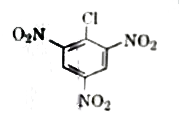Which of the following is most reactive towards nucleophilic substitution reaction ?




To determine which of the compounds (A, B, C, or D) is most reactive towards nucleophilic substitution reactions, we need to analyze the structure of each compound and the effects of substituents on the electrophilicity of the carbon atom bonded to the leaving group (in this case, a halogen like chlorine).
1. Understanding Nucleophilic Substitution:
- In a nucleophilic substitution reaction, a nucleophile attacks a carbon atom that is bonded to a leaving group (X, e.g., a halogen).
- The leaving group (X) departs, and the nucleophile takes its place.
2. Identifying Electrophilicity:
- The reactivity of the compound in nucleophilic substitution depends on the electrophilicity of the carbon atom. The more positive charge on the carbon, the more reactive it is towards nucleophiles.
- Electrophilicity can be increased by electron-withdrawing groups (EWGs) attached to the carbon.
3. Analyzing Each Compound:
- Compound A: Contains a chlorine atom (Cl) with no additional substituents. The carbon is relatively less electrophilic.
- Compound B: Contains a chlorine atom and an electron-withdrawing group (EWG) in the ortho position. This EWG will increase the positive character of the carbon, enhancing its electrophilicity.
- Compound C: Contains a chlorine atom and one EWG. This will also increase the electrophilicity but to a lesser extent than compound B.
- Compound D: Contains a chlorine atom and three electron-withdrawing groups. The presence of multiple EWGs significantly increases the positive charge on the carbon, making it the most electrophilic.
4. Conclusion:
- Among the compounds analyzed, Compound D has the highest number of electron-withdrawing groups, which maximizes the electrophilicity of the carbon atom. Therefore, it is the most reactive towards nucleophilic substitution reactions.
Final Answer:
The most reactive compound towards nucleophilic substitution is Compound D.
- In a nucleophilic substitution reaction, a nucleophile attacks a carbon atom that is bonded to a leaving group (X, e.g., a halogen).
- The leaving group (X) departs, and the nucleophile takes its place.
- The reactivity of the compound in nucleophilic substitution depends on the electrophilicity of the carbon atom. The more positive charge on the carbon, the more reactive it is towards nucleophiles.
- Electrophilicity can be increased by electron-withdrawing groups (EWGs) attached to the carbon.
- Compound A: Contains a chlorine atom (Cl) with no additional substituents. The carbon is relatively less electrophilic.
- Compound B: Contains a chlorine atom and an electron-withdrawing group (EWG) in the ortho position. This EWG will increase the positive character of the carbon, enhancing its electrophilicity.
- Compound C: Contains a chlorine atom and one EWG. This will also increase the electrophilicity but to a lesser extent than compound B.
- Compound D: Contains a chlorine atom and three electron-withdrawing groups. The presence of multiple EWGs significantly increases the positive charge on the carbon, making it the most electrophilic.
- Among the compounds analyzed, Compound D has the highest number of electron-withdrawing groups, which maximizes the electrophilicity of the carbon atom. Therefore, it is the most reactive towards nucleophilic substitution reactions.
The most reactive compound towards nucleophilic substitution is Compound D.
Topper's Solved these Questions
- QUESTION PAPER 2022 TERM 1 SET 2BOOK - XII BOARDS PREVIOUS YEARCHAPTER - QUESTION PAPER 2022 TERM 1 SET 2EXERCISE - SECTION -B
24 Videos
- QUESTION PAPER 2022 TERM 1 SET 2BOOK - XII BOARDS PREVIOUS YEARCHAPTER - QUESTION PAPER 2022 TERM 1 SET 2EXERCISE - SECTION -C
6 Videos
- QUESTION PAPER 2022 TERM 1 SET 1BOOK - XII BOARDS PREVIOUS YEARCHAPTER - QUESTION PAPER 2022 TERM 1 SET 1EXERCISE - SECTION-C
6 Videos
- QUESTION PAPER 2022 TERM 2 SET 1BOOK - XII BOARDS PREVIOUS YEARCHAPTER - QUESTION PAPER 2022 TERM 2 SET 1EXERCISE - SECTION - C
7 Videos
Similar Questions
Knowledge Check
Which of the following is most reactive toward nucleophilic substitution reaction ?
ACH2=CH−ClBC6H5−ClCCH3−CH=CH−ClDCl−CH2−CH=CH2Which of the following is most reactive towards nucleophilic substritution reaction?
AEthyl acetateBAcetic anhydrideCAcetamideDAcetyl chlorideWhich one of the following is most reactive towards nucleophilic substitution reaction ?
ACH2=CH−ClBC6H5ClCCH3CH=CH−ClDClCH2−CH=CH2
Which of the following is least reactive towards nucleophilic substitution?
View SolutionWhich of the following is most reactive towards electrophilic substituion reaction ?
View SolutionWhich one of the following is most reactive towards nucleophilic substitution reaction ?
View SolutionWhich of the following is most reactive towards nucleophilic addition reactions ?
View SolutionWhich of the following is most reactive towards nucleophilic addition reactions ?
View Solution
